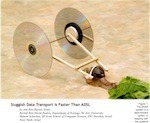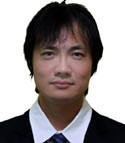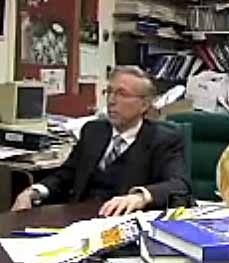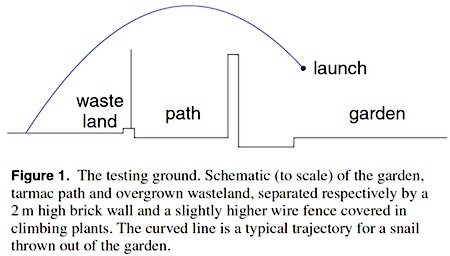Marc Abrahams's Blog, page 403
May 16, 2014
The Effectiveness of Snail-Throwing
Three things — (1) gardeners, (2) snails, and (3) the question of whether the latter (not the former) have a homing instinct — dominate the narrative in this new study:
“Snails home,” David J. Dunstan [pictured here] and David J. Hodgson, Physica Scripta, vol. 89, no. 6, 2014, 068002. The authors, at Queen Mary University of London and the University of Exeter, Penryn Campus, Penryn, Cornwall UK, report:
“It has frequently been reported that snails that are marked and removed from a garden are later found in the garden again…. We report a systematic study of the snail population in a small suburban garden, in which large numbers of snails were marked and removed over a period of about 6 months. [We] infer the existence of two groups of snails in the garden: members of a larger population that show little affinity to the garden itself, and core members of a local garden population that regularly return to their home if removed. The data are strongly suggestive of a homing instinct, but also reveal that snail-throwing can work as a pest management strategy.”
Here’s detail from the study:
Karen Kaplan reports further details in the Los Angeles Times, under the headline “Snails in your garden? Warm up your throwing arm, scientists suggest“.
 BONUS: A set of now-old-fashioned guidelines for dealing with snails and slugs in one’s garden
BONUS: A set of now-old-fashioned guidelines for dealing with snails and slugs in one’s garden
BONUS (possibly unrelated): “Sluggish Data Transport Is Faster Than ADSL“

The effect of potholes in the path of helmeted guinea fowl
What happens when Helmeted Guinea Fowl, out walking, encounter an unexpected pothole? Do they fall over? That depends, in quite an improbable way, on whether they see it coming or not …
In 2005, a research team at Concord Field Station, the Museum of Comparative Zoology, Harvard University, US, endeavoured to clarify things by encouraging Guinea Fowl [* see note below] to walk along a raised platform which had a hidden drop covered with a fragile layer of stretched tissue paper. With potentially counter-intuitive results. When the birds couldn’t see the drop, hardly any stumbled, but when they could (tissue paper removed) quite a few of them did.
“Our results show that, despite altered body dynamics and a great deal of variability in the response, guinea fowl are quite successful in maintaining dynamic stability, as they stumbled only once (without falling) in the 19 unexpected perturbations. In contrast, when the birds could see the upcoming drop in terrain, they stumbled in 4 of 20 trials (20%, falling twice), and came to a complete stop in an additional 6 cases (30%).”
Full details can be found here in : ‘Running over rough terrain: guinea fowl maintain dynamic stability despite a large unexpected change in substrate height’ by Monica A. Daley, James R. Usherwood, Gladys Felix and Andrew A. Biewener, January 1, 2006, Journal of Experimental Biology, 209, 171-187.
Additionally, the authors provide several slow-motion videos [all in .avi format] showing the birds very successfully negotiating the unexpected potholes: here: here and here. And not quite so successfully here. [*note: With a broom - visible at the end]
BONUS : A video in which the paper’s lead author (and Chicken of The Future participant) Dr. Monica Daley, HBSc MA PhD PGCAP FHEA, provides ‘some observations on leg control for running from experimental data on ground birds’. (the pothole clip features at around 10:15)

Phoenix: Cooling down the buildings, but maybe not the city
People use air conditioning to, on a small scale, cool off . This report measures the degree and degrees to which it can, on a larger scale, do the opposite:
“Anthropogenic Heating of the Urban Environment due to Air Conditioning,” Francisco Salamanca [pictured here], M. Georgescu, A. Mahalov, M. Moustaoui, and M. Wang, Journal of Geophysical Re
search: Atmospheres, epub March 6, 2014. (Thanks to investigator Stephen Rector for bringing this to our attention,) The authors, at Arizona State University, report about what happens in and above the city of Phoenix:
“This article investigates the effect of air-conditioning (AC) systems on air temperature and examines their electricity consumption for a semiarid urban environment…. during the night, heat emitted from AC systems increased the mean 2 m-air temperature by more than 1 °C for some urban locations. The AC systems modified the thermal stratification of the urban boundary layer promoting vertical mixing during nighttime hours…. Our results demonstrate that releasing waste heat into the ambient environment exacerbates the nocturnal urban heat island and increases cooling demands.”
BONUS: The New Times asked, years ago, whether Phoenix can ever be cool:
 BONUS SONG: Phoenix — “Trying to be Cool”:
BONUS SONG: Phoenix — “Trying to be Cool”:

May 15, 2014
The recent further adventures of Troy Hurtubise: whacked in the head
In these videos, both apparently from the same event in late 2013, Ig Nobel Prize winner Troy Hurtubise demonstrates his technology that protects him, to some degree, even when a large man whacks Troy in the head with a baseball bat:
BONUS (possibly, but not necessarily, unrelated): “Brazil unveils ‘Robocop’ suit to protect super-elite police unit during World Cup“

A look back at CBS News’ look at the 2006 Ig Nobel Prize winners
Woodpeckers & headaches. Spaghetti breaking. Fingernails on a chalkboard. Group photos of people who blink. In 2006, a CBS Evening news crew filed this TV report about that year’s Ig Nobel Prize winners (and a notorious-duck story that made a return visit):

And no more with the hearty handshakes, they suggest
While some researchers urge the public, especially children, to come in more contact with common dirt — and thus presumably boost their immune systems by exercising them against a wide range of threatening thisandthat — other researchers point adults towards the opposite direction. At present, it seems unlikely that these two research camps will soon join hands. Witness a new study by the shaky-about-tolerating-handshakes group:
“Banning the Handshake From the Health Care Setting,” Mark Sklansky [pictured here, demonstrating one way to not shake hands], Nikhil Nadkarni, Lynn Ramirez-Avila, Journal of the American Medical Association, epub May 15, 2014. (Thanks to investigator Ivan Oransky for bringing this to our attention.) The authors, at Mattel Children’s Hospital UCLA, and Ronald Reagan UCLA Medical Center, Los Angeles, California, explain:
“The infectious risk of the handshake has been described in the medical literature since the early 20th century. Multiple studies have demonstrated that the handshake can and does transmit pathogens, and widespread hand hygiene policies have been predicated on the well-established link between hand transmission of pathogens and disease. Bacterial cross-contamination of volunteers through handshaking has been found to be more likely than with “fist bumping” on a surgical ward. Clostridium difficile spores (a common cause of diarrhea in the health care setting) have been demonstrated to be transmitted via the handshake. Moreover, the survival of bacteria transmitted via the handshake has been found to be prolonged in the presence of sputum….
“Banning the handshake from the health care environment may require further study to confirm and better describe the link between handshake-related transmission of pathogens and disease…. Given the tremendous social and economic burden of hospital-acquired infections and antimicrobial resistance, and the variable success of current approaches to hand hygiene in the health care environment, it would be a mistake to dismiss, out of hand, such a promising, intuitive, and affordable ban.”

A further delay in the arrival of a universal drug creation machine
 The new great attempt to make a machine that can conveniently make and deliver any —any — kind of drug has hit a snag. The previous great attempt, by two-time Ig Nobel Prize winner Jacques Benveniste, hit a snag two decades ago, and never got unsnagged.
The new great attempt to make a machine that can conveniently make and deliver any —any — kind of drug has hit a snag. The previous great attempt, by two-time Ig Nobel Prize winner Jacques Benveniste, hit a snag two decades ago, and never got unsnagged.
The Retraction Watch blog sums up the new case:
Paper claiming a way to “print any drug instantly” gets unprinted
A recent paper proposing a way to “print any drug instantly” has been withdrawn by the author, following bewildered reactions from the blogosphere.
The paper made the rounds at various chemistry-focused blogs last month. Derek Lowe of In The Pipeline picked up on it too, calling the article “one of the oddest papers to appear in Drug Discovery Today, which is saying something.” …
Indeed, here’s the notice — a deeply uninformative one, we note — at Drug Discovery Today: “This article has been withdrawn at the request of the author. The Publisher apologizes for any inconvenience this may cause.”…
The paper’s author is Prof. Calvin Yu-Chian Chen [pictured here, above], who does not lack for words.
Dr Chen’s work both follows and extends the work done long ago by Jacques Benveniste.
Dr. Benveniste was awarded the 1998 Ig Nobel Prize for chemistry, for his homeopathic discovery that not only does water have memory, but that the information can be transmitted over telephone lines and the Internet. [REFERENCE: "Transatlantic Transfer of Digitized Antigen Signal by Telephone Link," J. Benveniste, P. Jurgens, W. Hsueh and J. Aissa, Journal of Allergy and Clinical Immunology - Program and abstracts of papers to be presented during scientific sessions AAAAI/AAI.CIS Joint Meeting February 21-26, 1997"]
The 1998 Ig Nobel Prize added to Dr. Benveniste’s collection of honors. In 1991 he was awarded the very first Ig Nobel Prize for chemistry, for his persistent discovery that water, H2O, is an intelligent liquid, and for demonstrating to his satisfaction that water is able to remember events long after all trace of those events has vanished.
Dr. Benveniste’s initial great discovery was published in the journal Nature, which then quickly retracted that paper. Years later, after Dr. Benveniste’s death, Nature published his obituary (and has not, at least not yet, retracted that).

Got a problem? Want one? (Specifically, a physics problem)
If you are one of the rare people who have no problems and who also, for whatever reason, want one, here’s a list to choose from. You can find details, and even solutions, at David Morin [pictured here]‘s Problem-of-the-Week list on the Harvard physics department web site. There are 90 problems there. Among them:
Leaving the hemisphere, Tower of cylinders, Standing in a line, Rainbows, Nine divisible by 9, Propelling a car, Crawling ant, Hanging chain, Painting a funnel, Compton scattering, Tower of circles, Bowl of spaghetti, Attracting bugs, Leftover dental floss, Falling rope, Cereal box prizes, Getting way ahead, The hotel problem, Sliding ladder, The birthday problem, Sliding along a plane, Speedy travel, Viewing the spokes, Counterfeit coin, Simultaneous claps, Relativistic cookies, Trading envelopes, Ball on turntable, Letters in envelopes, Break or not break?, Mountain climber, The raindrop, Passing the spaghetti, Balancing a pencil.
David Morin also has some books.
(Thanks to Michael Warrington for indirectly and intriguingly bringing this to our attention.)

A stranger sings a song tribute to the 2013 Ig Nobel Prize winners
May 14, 2014
Profiling Professor Persinger – part 3
 Can ‘Reality’ be ‘Bifurcated’? If so, what would be the energy required to do so? Could a human brain bifurcate reality? And, if one brain had managed to achieve the critical threshold energy to do so, would other observers existing within the same space-time frame also perceive related phenomena? All these questions are examined by professor Michael A. Persinger of the psychology dept. at Laurentian University, Ontario, Canada in a paper for NeuroQuantology, 2008; 3: 262-271
Can ‘Reality’ be ‘Bifurcated’? If so, what would be the energy required to do so? Could a human brain bifurcate reality? And, if one brain had managed to achieve the critical threshold energy to do so, would other observers existing within the same space-time frame also perceive related phenomena? All these questions are examined by professor Michael A. Persinger of the psychology dept. at Laurentian University, Ontario, Canada in a paper for NeuroQuantology, 2008; 3: 262-271
“… the calculations, solutions, and implications developed in this paper suggest that the energies associated with human thought may have at present unfathomable impact upon the structure, dynamics, history, and outcome of the entire universe in which we exist. Quantitative solutions indicate that the quantal energies involved with the physical bases of human thought are coupled from the smallest increments of space to the entire conceptual set: the universe.”
And the implications, according to the professor, could hardly be profounder.
“The future of our fate as a species and the universe in which it occurs may depend upon our complete comprehension of the implications of NeuroQuantology.”
See: Persinger M. A., Koren S. A., Lafreniere G. F. (2008). A neuroquantologic approach to how human thought might affect the universe.
Other Prof. Persinger publications include :
Persinger, M.A. On the possibility of directly accessing every human brain by electromagnetic induction of fundamental algorithms. Perceptual and Motor Skills, 1995, 80, 791-799.
Persinger, M.A. Wars and increased solar-geomagnetic activity: Aggression or change in intraspecies dominance? Perceptual and Motor Skills, 1999, 88, 1351-1355.
Kowalski, S., Parker, G.H., & Persinger, M.A. Interactions of 2-ppm lead in the water supply with food deprivation upon maze-swimming behavior of mice. Perceptual and Motor Skills, 1982, 55, 515-519.
BONUS: A little slow to gather pace, but nonetheless an interview with the professor:
This concludes our Improbable Profile of Professor Persinger

Marc Abrahams's Blog
- Marc Abrahams's profile
- 14 followers






